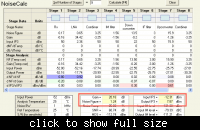Hi-Tone
Member level 1
- Joined
- Nov 23, 2010
- Messages
- 32
- Helped
- 2
- Reputation
- 4
- Reaction score
- 2
- Trophy points
- 1,288
- Location
- Copenhagen, Denmark
- Activity points
- 1,501
Hi.
I have an AppCad simulated system with Noise Figure of 1.30 dB. The simulation doesn't consider return loss (or the return loss is seen as infinite). Now, when I measure the system I get:
Noise Figure = 4 dB.
Input return loss = 12.5 dB.
Output return loss = 8 dB.
Could my VERY high noise figure of 4 dB be because my input/output return loss is bad? or does the return loss not affect the noise figure at all?
Thanks a lot, I really appreciate it.
I have an AppCad simulated system with Noise Figure of 1.30 dB. The simulation doesn't consider return loss (or the return loss is seen as infinite). Now, when I measure the system I get:
Noise Figure = 4 dB.
Input return loss = 12.5 dB.
Output return loss = 8 dB.
Could my VERY high noise figure of 4 dB be because my input/output return loss is bad? or does the return loss not affect the noise figure at all?
Thanks a lot, I really appreciate it.


